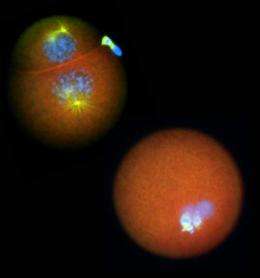Rediscovery: Scientists confirm role for mysterious cell component, the nucleolinus

When searching for long-lost treasure, sometimes all you need is a good flashlight.
Such a "flashlight," developed at the Marine Biological Laboratory's (MBL) Josephine Bay Paul Center, has been used to illuminate a long-neglected cellular component - the nucleolinus - and confirm its role in cell division. MBL scientists Mark Alliegro and Mary Anne Alliegro, and MBL visiting investigator Jonathan Henry of University of Illinois, Urbana, present their discoveries regarding the nucleolinus this week in a paper in Proceedings of the National Academy of Sciences.
The nucleolinus is a structure observed in the nucleus of many cells, including invertebrate egg cells and some mammalian cells. While it was discovered more than 150 years ago, and other scientists have proposed that is involved in cell division, difficulties in visualizing the nucleolinus inside most cells have kept that hypothesis dormant.
"Our paper reintroduces (a cell component) that was discovered and forgotten long ago," Mark Alliegro says. "When we saw a couple of interesting things about the nucleolinus, I asked, 'What does it do?' I went to the library and quickly found out that nobody knew."
He and his colleagues went on to develop a probe that binds to specific nucleolinar molecules in egg cells of the surf clam Spisula solidissima. Using the label to keep an eye on the nucleolinus, they found that it was associated with structures required for cell division. Follow-up experiments in which the nucleolinus was targeted by a laser resulted in failed cell division and disruption of structures necessary for the process.
"We've known for a long time that there are elements in the cytoplasm that need to be assembled for the cell to divide," Mark Alliegro says. "But this tells us that elements in the cytoplasm and in the nucleus have to join together to make the apparatus that separates chromosomes [an important part of cell division]."
This function of the nucleolinus, which is closely associated with a structure called the nucleolus, could clarify recent studies indicating an important role for the nucleolus in cell division. "When people talk about the nucleolus playing a direct role in cell cycle regulation, it may very well be that it's the nucleolinus," Mark Alliegro says.

Mark Alliegro and his colleagues speculate that the nucleolinus may be responsible for recruiting proteins required by centrosomes, which have long been known to play an important role in cell division. "What we're doing now is attempting to answer some functional questions about the nucleolinus in Spisula cells," he says. "But we're also moving it into other systems that are easier to experiment in." They are planning to study the role of the nucleolinus in mammalian cells.
The MBL has other close connections with the long but sparse history of nucleolinus research. Former MBL visiting investigators Thomas H. Montgomery Jr. of the University of Texas (in the 1890s) and Robert D. Allen of Dartmouth College (in the 1950s) both studied the structure before it faded back into obscurity. "Of the people that have studied the nucleolinus," Mark Alliegro says, "more have been at the MBL than any place else."
More information: Alliegro, M. A., Henry, J. J., Alliegro, M. C. (2010) Rediscovery of the Nucleolinus, a Dynamic RNA-Rich Organelle Associated with the Nucleolus, Spindle, and Centrosomes. Proc Natl Acad Sci USA: www.pnas.org/cgi/doi/10.1073/pnas.1008469107
Provided by Marine Biological Laboratory















